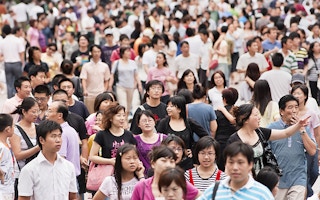The world’s cities are growing even faster than the human population. Within the last 40 years, the global population has increased by a factor of 1.8, but built-up areas have multiplied 2.5 times.
All of this information, and much more, appears in a new European Commission (EC) publication called the Atlas of the Human Planet, prepared to coincide with the recent third UN Habitat conference in Quito, Ecuador.
The Atlas shows that, 40 years ago, most of the world’s 4.1billion population lived in rural areas. Now more than half live in towns and cities − urban clusters that cover 7.6 per cent of the planet’s land mass, equivalent to an area about half the size of the European Union.
Most of the people in the world are crammed into urban centres with a density greater than 1,500 persons per square kilometre, and in settlements greater than 50,000 inhabitants.
Altogether, geographers have identified 13,000 urban centres, altogether surrounded by 300,000 “urban clusters” of at least 5,000 inhabitants living at a density of 300 per square kilometre.
Population tripled
And in the 40 years since the first UN Habitat conference in 1976, the population of Africa has tripled, while the built-up area of the continent has quadrupled. In wealthy Europe, the population remained stable, but the built-up area doubled.
The research for the Atlas has been enriched by a new, free, open and global dataset, the Global Human Settlement Layer, developed by the EC’s Joint Research Centre, and based on 12,400 billion individual satellite data readings over the past four decades. It provides, in every sense, an overview of a planet at work and at rest and struggling to survive.
It confirms what most people would have suspected: that nine of the 10 most densely populated urban centres – including Cairo in Egypt, Guangzhou in China, and Jakarta in Indonesia – are in the low-income countries.
The largest urban centre in the world is Los Angeles in the US, eight of the 10 largest urban centres are in the high-income countries, and five of those are in the US.
And a group of scientists led by Timon McPhearson, assistant professor of urban ecology at the New School in New York, publish a warning in Nature journal that more urban areas will be built in the next 30 years than ever before just to house and shelter the additional 1.1billion people expected in the next 14 years − most of them in the crowded cities of Asia and Africa.
Whatever problems these new city-dwellers have will be compounded, other researchers warn, by climate change − with ever more frequent and intense heatwaves, droughts, floods, and days of bad air quality.
Around 40 per cent of the world’s people live in coastal cities, and are therefore increasingly vulnerable to floods, tsunamis, surges and tropical storms.
Because of the notorious urban “heat island effect”, cities are inevitably hotter than the surrounding countryside, and many are likely to face a crisis in the supply of safe, clean water.
Swelling cities
The new Atlas warns that the new, swelling cities will go on making ever greater demands on the farmland and wilderness beyond the city’s boundaries.
In the last 15 years, 27,000 sq km of land was covered by housing, workshops and pavement. This is an area equal to Cyprus and Israel combined.
If this growth continues at the present rate, an additional 1.1 million sq km of land will become built-up between 2015 and 2040 − an area equal to the size of Ethiopia.
In 119 countries, the urban population is between 70 per cent and 90 per cent of the total. In 25 countries – most of them in Asia – the city dwellers make up 90 per cent of the population. Many of these are in megacities.
The atlas records 50 “urban clusters” of more than 10 million people, and one gigacity − Beijing − that is home to more than 100 million.
Inevitably, in this growth explosion, the poorest are often most at risk, from floods, landslides, and other geophysical and climate-related potential disasters.
In the last 40 years, the number of people living at or even below sea level has almost doubled from 45 million to 88 million, and the number living on steep slopes has increased from 70 million to 160 million.
This story was published with permission from Climate News Network.

















